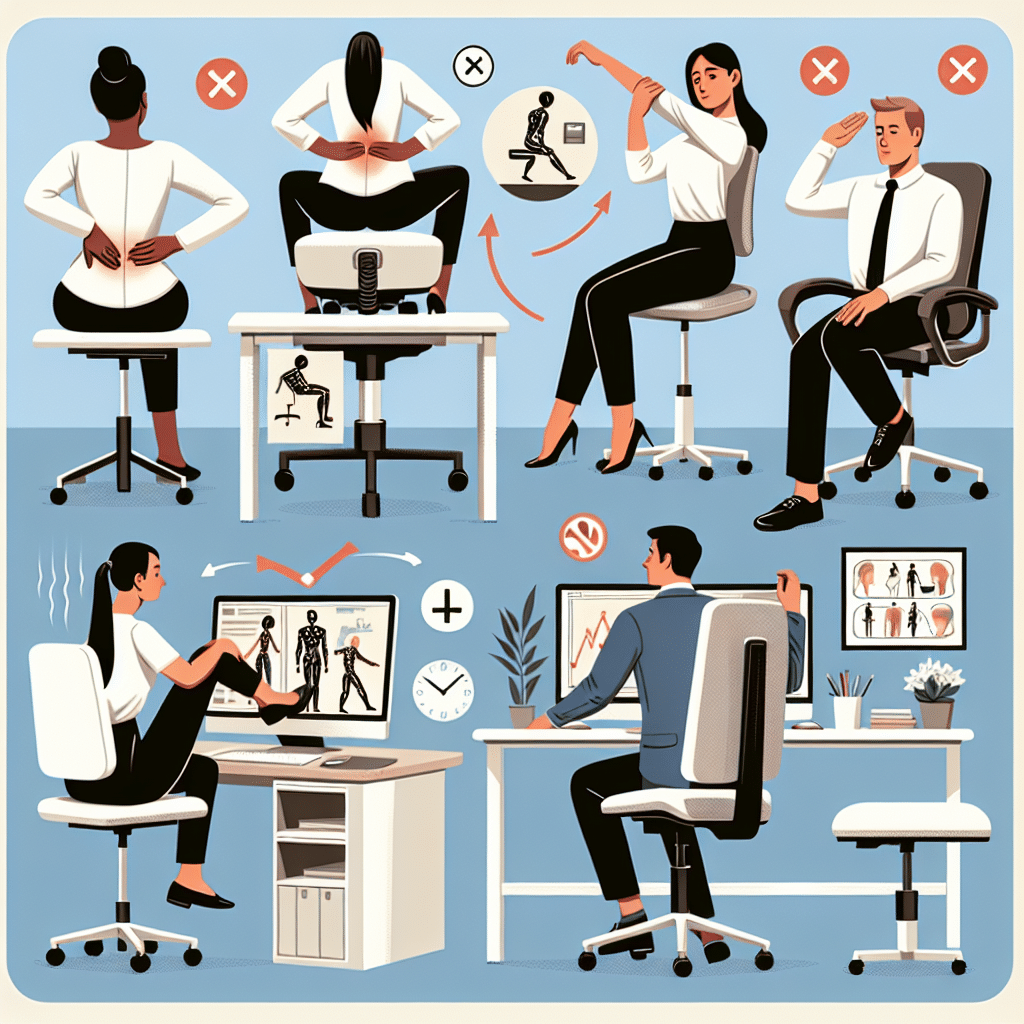Essential Tips for Preventing Back Pain at Your Desk
1. Optimize Ergonomics
When working at a desk, your workspace setup is crucial for preventing back pain. Adjust your chair, monitor, and keyboard so that they promote an ergonomic posture.
-
Chair Height: Your feet should remain flat on the ground, and your knees should be at or below hip level. A chair with lumbar support will keep your spine’s natural curve intact.
-
Monitor Position: The top of your monitor should be at eye level or just below, allowing a slight downward gaze. This prevents straining your neck and upper back.
-
Keyboard and Mouse Setup: Keep your keyboard at elbow height, and your mouse close enough to avoid reaching. This setup reduces shoulder strain.
2. Maintain Good Posture
Posture plays a significant role in overall back health.
-
Sit Up Straight: Your back should be straight, with shoulders relaxed and aligned. Avoid slumping or leaning forward.
-
Proper Alignment: Ears, shoulders, and hips should be in a vertical line. This alignment helps distribute weight evenly across your spine.
3. Take Frequent Breaks
Sitting for prolonged periods can lead to stiffness and pain.
-
The 20-20-20 Rule: Every 20 minutes, take a 20-second break to look at something 20 feet away. This reduces eye strain and encourages movement.
-
Stand Up Bi-Hourly: Make it a habit to stand up and stretch or walk around every 1 to 2 hours.
4. Incorporate Stretching and Movement
Physical activity helps maintain flexibility and reduce tension.
-
Desk Stretches: Perform simple stretches like neck rolls, shoulder shrugs, and spinal twists to keep muscles relaxed.
-
Walking During Breaks: Utilize breaks for a quick walk to promote circulation and reduce muscle tension.
5. Choose the Right Chair
Investing in a quality chair can significantly affect your back health.
-
Adjustable Features: Look for a chair with adjustable height, backrest, and armrests to support your individual needs.
-
Quality Material: A chair with breathable fabric adds comfort during long work hours.
6. Consider a Standing Desk
Alternating between sitting and standing can alleviate pressure on your back.
-
Adjustable Standing Desks: Consider desks that can be raised or lowered for a customized height. This allows you to switch positions throughout the day.
-
Proper Footwear: If using a standing desk, wear supportive shoes to prevent fatigue and lower back pain.
7. Use Supportive Accessories
Several tools can enhance your desk setup.
-
Footrests: For those who find their feet dangling, a footrest can provide necessary support to avoid strain.
-
Lumbar Supports: Adding a lumbar roll or cushion can enhance your chair’s support and maintain spinal curvature.
8. Hydrate Regularly
Dehydration can contribute to muscle fatigue and discomfort.
-
Keep Water Nearby: Having water within reach encourages you to hydrate throughout the day, promoting overall health and wellness.
-
Set Reminders: Consider using apps or alarms to remember to drink water regularly.
9. Manage Stress
Stress can lead to muscle tension and pain.
-
Mindfulness Techniques: Incorporating deep breathing exercises or short meditation practices can alleviate stress and its physical manifestations.
-
Plan Breaks: Schedule intentional breaks to help lower stress and clear your mind.
10. Exercise Regularly
Regular physical activity strengthens muscles and improves flexibility.
-
Strength Training: Focus on core-strengthening exercises to support your back and improve posture.
-
Aerobic Fitness: Engaging in activities like walking, cycling, or swimming helps increase blood flow and build endurance.
11. Adjust Screen Brightness
Poor lighting and screen glare can strain your body.
-
Maintain Appropriate Levels: Brightness should match the ambient light of your workspace to reduce eye fatigue, which can lead to poor posture.
-
Anti-Glare Screens: If your workspace has a lot of light, consider investing in anti-glare screens to protect your eyes.
12. Avoid Clutter
A disorganized workspace can lead to unnecessary strain.
-
Organize Regularly: Keep essential items within arm’s reach to minimize stretching or straining.
-
Cable Management: Tidy up cables to avoid tripping hazards that can lead to sudden movements that may strain your back.
13. Behavioral Adjustments
Adjustments to daily habits can also contribute to back health.
-
Avoid Phone Cradling: Use a headset or speakerphone to avoid curling your neck when taking calls.
-
Limit Slouching: Before being seated, take a moment to consciously check your posture and align your body before beginning work.
14. Know Your Limitations
Recognizing when to seek help or make changes is vital.
-
Listen to Your Body: If you feel discomfort, take it seriously. Pushing through pain can lead to chronic issues.
-
Consult Specialists: If back pain persists, consider seeking help from a healthcare provider, physical therapist, or ergonomic specialist who can offer tailored advice.
15. Manage Technology Usage
Excessive use of technology can lead to poor habits.
-
Device Positioning: Elevate tablets and smartphones to avoid bending over.
-
Limit Continuous Use: Be aware of time spent on devices and set periodic intervals to change positions.
16. Use Visual Reminders
Visual cues can reinforce healthy habits.
-
Posture Reminders: Place reminders at your workspace to check your posture throughout the day.
-
Set Alarms for Breaks: Use your phone or computer to remind you to take breaks and stretch.
Engaging in proactive measures to prevent back pain while working at your desk can greatly enhance your productivity and overall well-being. Implementing these essential tips will transform not only your work environment but also your physical health, leading to a more comfortable and enjoyable working experience.
